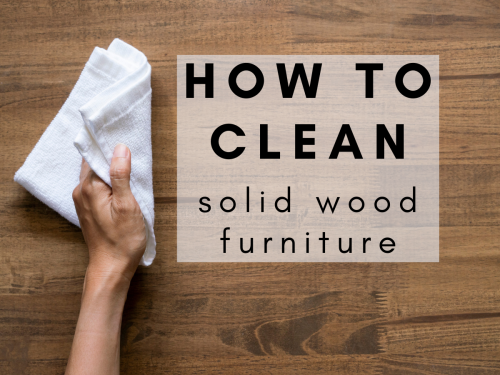How Should I Clean My Solid Wood Furniture?
By Bailiegh Basham · February 1, 2021
Amish Furniture Care and Maintenance
Routine Cleaning
Your main goal of routine cleaning is to simply remove dust. Dry dusting with a microfiber cloth is what you will do most of the time. We recommend a professional grade cloth with 300 GSM (grams per square meter). Dust as often as you like with a clean, dry, soft cloth following the wood’s grain.
For tougher spots, wipe your furniture down with a damp cloth. Be sure to use a gentle, diluted cleaner like our Tough and Tender, or even dish soap. The key is to dry the table with a clean soft cloth; avoid using coarse scratchy cloths, or paper towels
Deep Cleaning (Once or Twice a Year)
To polish means to make the surface smooth and glossy. Polishes fill surface scratches to diffuse the light and make scratches less noticeable. Use a silicone-free furniture polish only a few times a year. We recommend Plush Cabinet and Furniture Polish and Restorer. Plush dries free of any oily residue, resists fingerprints when dry, and does not alter the original sheen. Apply Plush to a microfiber cloth and then apply to the entire surface then wipe dry with another microfiber cloth. Again, try to follow the grain of the wood.
Similar to our Plush furniture polish, Oz polish also protects your furniture from harmful UV rays and gives it a subtle shine. Apply Oz to a microfiber cloth and then apply to the entire surface and then wipe dry with another microfiber cloth.
Glass Cleaning
Cleaning glass is always tricky. Some products break promises and leave streaks, and using newspapers to dry is effective but messy. We recommend using Heirloom Essentials Spotless Furniture and Glass Cleaner. This product has a unique streak-free formulation making it possible to clean varnished wood furniture, glass, mirrors and many other hard surfaces quickly and easily.
All-Purpose Cleaning
We recommend Tough & Tender Concentrated Cleaner for every day, all-purpose cleaning. One 16 ounce bottle of concentrate will fill six, 16 ounce spray bottles. It is eco-friendly and powered by nature. Free of ammonia, chlorine and phosphate, it is a cleaner you can trust on your finest furniture. Tough & Tender is great for cleaning countertops, cabinets, walls, appliances, and even light fixtures.
How can I keep my furniture in pristine condition?
Since excessive heat and extremes in relative, or indoor, humidity are not good for any wood product, the secret to youthful furniture is to moderate both of these.
Relative Humidity
Just enough humidity keeps your handcrafted wood furniture supple and fresh. On the contrary, too much humidity makes your furniture expand, and not enough humidity is the solid wood equivalent to dry wrinkled skin. Wood is very sensitive to changes in relative humidity. As the weather changes, so does the relative humidity in your home and in the moisture content of the wood in your furniture. This means that furniture is constantly expanding and contracting. Ideally, the relative humidity in your home should be between 40 -45%. In the summer, relative humidity is more likely to be high, but central air conditioning helps regulate this. If it is too high, consider running a dehumidifier. Conversely, in the winter, when air is already dry, heating your home aggravates the problem. You might need a humidifier to add moisture back into your home. Most of the time, if you are comfortable, your relative humidity is probably in this range, but you can use a hygrometer to get an accurate reading.
Excessive Heat
Just like the sun's harmful rays can burn your skin, excessive heat can scar and burn your fine wood furniture. Wood does best in moderate conditions of around 70°F. If possible, place your furniture away from all heat sources including under or over heat vents. If you must put furniture near an air duct, use a shield or guard to direct the heat away. Always protect your table from hot pans and dishes, and look for hot pads or trivets that will not trap steam between your pan and the table. Wicker trivets are the worst offenders. Also, if you must temporarily store your beautiful Amish furniture, look for a climate controlled storage space. Avoid warm attics, damp basements, and hot storage sheds.

How do you clean a real hardwood dining table?
While it might seem complicated to clean wood, a simple approach is always best. For every day cleaning, wipe your table using a soft, damp cloth moistened with a gentle diluted soap or warm dish water. Follow the grain of the wood, and gently scrub to remove dust and grime. Avoid soaking the wood in water, and once the spot is cleaned, wipe the area dry with another microfiber cloth. For a deep clean, only a few times a year, you can protect your table with a silicone-free furniture polish. Let the polish sit on the wooden surface for a few minutes before buffing it in with a clean microfiber cloth. Avoid polish sprays, which can leave a residue. This is also a good time to clean table leaves or extenders and to make sure they're functioning properly.
For more details, read our blog post: Top 10 Tips for Cleaning Solid Wood Furniture.


